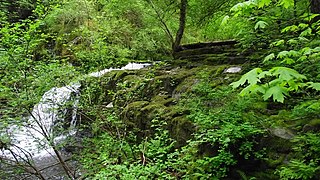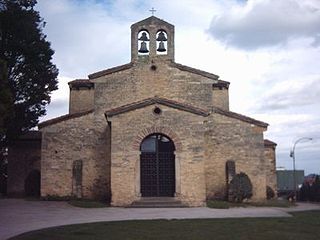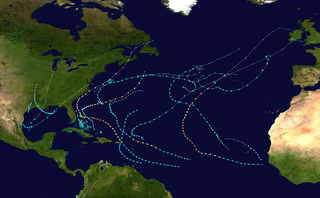
In geology, the places known as hotspots or hot spots are volcanic regions thought to be fed by underlying mantle that is anomalously hot compared with the surrounding mantle. Examples include the Hawaii, Iceland and Yellowstone hotspots. A hotspot's position on the Earth's surface is independent of tectonic plate boundaries, and so hotspots may create a chain of volcanoes as the plates move above them.

Oviedo is one of 8 comarcas of the province and autonomous community of Asturias in Spain.

Proaza is a municipality in the Autonomous Community of the Principality of Asturias, Spain. It is bordered on the north by Santo Adriano and Grado, on the south by Teverga and Quirós, on the west by Yernes y Tameza and Teverga, and on the east by Quirós.

Yernes y Tameza is a municipality in the Autonomous Community of the Principality of Asturias, Spain. It is situated in the east-central zone of the principality, between mountains high along the Cubia River. It is bordered on the west, north, and northeast by Grado, on the southeast by Proaza, and on the south by Teverga. The municipality has an abrupt topography, most notable in the peak Caldoveiru (1,357 m) and the Tameza River, which crosses the municipality from south to north.

Errington is a small community on Vancouver Island, British Columbia, Canada, located on Errington Road, off Highway 4, just south of Parksville and Qualicum Beach.
In 356, after leaving Cologne, Roman Emperor Julian the Apostate wintered in Senonae in Gaul. Following desertions from his German federated troops, hostile Germanic warbands learned that his force was under-strength and moved to attack the town. However, lacking advanced siegecraft, they were not able to break into the town and could only prevent Julian from venturing outside the walls. After a month, they withdrew.
Finally, after a month the savages withdrew crestfallen, muttering that they had been silly and foolish to have contemplated the blockade of the city. But — a thing to be regarded as a shameful situation — while Caesar was in jeopardy, Marcellus, master of the horse, although he was stationed in neighbouring posts, postponed sending him reinforcements; whereas even if the city alone was endangered, to say nothing of the prince's presence there, it ought to have been saved from the hardships of blockade by the intervention of a large force.
Village Christian School is a private Christian school established in 1994 by Dwight and Kitty Hesson. It is located on the property owned and operated under the auspices of Mid-Western Children’s Home.

Ardesaldo is one of 28 parishes in Salas, a municipality within the province and autonomous community of Asturias, in northern Spain.

Idarga is one of 28 parishes in Salas, a municipality within the province and autonomous community of Asturias, in northern Spain.

Santiago de la Barca is one of 28 parishes in Salas, a municipality within the province and autonomous community of Asturias, in northern Spain.

Santullano is one of 28 parishes in Salas, a municipality within the province and autonomous community of Asturias, in northern Spain.

Villazón is one of 28 parishes in Salas, a municipality within the province and autonomous community of Asturias, in northern Spain.
Santianes is one of thirteen parishes in Teverga, a municipality within the province and autonomous community of Asturias, in northern Spain.
Zardaín is one of 44 parishes in Tineo, a municipality within the province and autonomous community of Asturias, in northern Spain.

Yerne is a river of Belgium. It flows for 15.5 kilometres (9.6 mi) through the province of Liège in the northern-central part of the country.

Caldoveiro Peak is a protected mountain range in Asturias, Northern Spain, with a maximum peak of 1,357 meters, near the village of Villabre. It spans the parishes of Yernes, Proaza, Tameza, Grau (Grado), and Teberga (Teverga). Minerals found in Caldoveiro mines include Fluorite, Calcite, and Quartz. The Asturian administration uses Caldoveiro Peak in its tourism advertising, describing the mountain range as so:
The varied vegetation of this nature area and the different processes of erosion that sculpt contrasting terrain form a picturesque landscape dotted with small mountain lakes and high pastures with stone huts known as corros.

The 2018 Atlantic hurricane season was an event in the annual hurricane season in the north Atlantic Ocean. It as an above-average season for tropical cyclones for the third consecutive year. Though the season officially began on June 1, 2018 and ended November 30, 2018, dates adopted by convention and historically describe the period during each year when most tropical cyclones form, it effectively started with the formation of Tropical Storm Alberto on May 25. The season's final storm, Hurricane Oscar, dissipated on October 31.

The 2019 Atlantic hurricane season was an event in the annual tropical cyclone season in the north Atlantic Ocean. It was the fourth consecutive above-normal Atlantic hurricane season. The season officially began on June 1, 2019 and ended on November 30, 2019. These dates, adopted by convention, historically describe the period in each year when most tropical systems form. However, storm formation is possible at any time of the year, as demonstrated in 2019 by the formation of the season's first named storm, Subtropical Storm Andrea, on May 20. The final storm of the season, Tropical Storm Sebastien, transitioned to an extratropical cyclone on November 25.
The Ophis, also called the Ophius or Ophious (Ὀφιοῦς), was a river of ancient Pontus, the mouth of which was 90 stadia to the east of port Hyssus, and which separated Colchis from the country of the Thianni.














